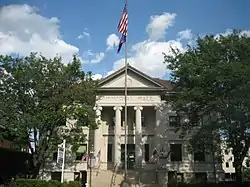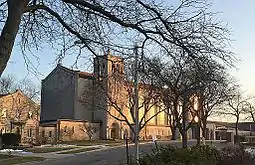Rockford, Illinois
Rockford is a city in Winnebago County, Illinois, United States, located in the far northern part of the state. Situated on the banks of the Rock River, Rockford is the county seat of Winnebago County (a small portion of the city is located in Ogle County). The largest city in Illinois outside of the Chicago metropolitan area, Rockford is the fourth-largest city in the state and the 171st most populous in the United States.[8] According to 2010 U.S. Census data, the City of Rockford had a population of 152,871, with an outlying metropolitan area population of 348,360. The City of Rockford's population was 145,609 as of 2019,[9] down 5.0% since 2010.[10]
Rockford, Illinois | |
|---|---|
| City of Rockford | |
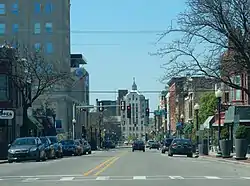 Downtown East State Street corridor | |
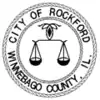 Seal | |
| Nicknames: | |
| Motto(s): "The Government Closest to the People" | |
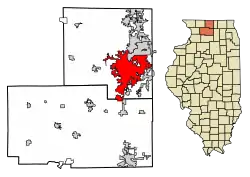 Location of Rockford in Winnebago County, Illinois | |
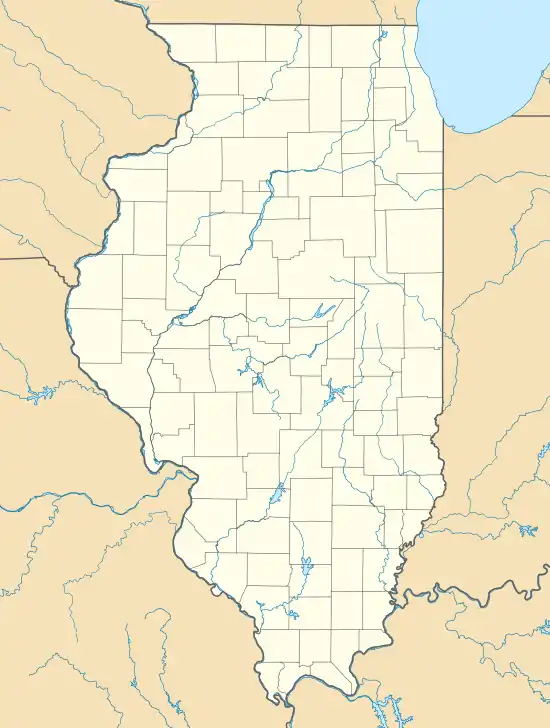 Rockford, Illinois Location in Illinois  Rockford, Illinois Rockford, Illinois (the United States) | |
| Coordinates: 42°15′34″N 89°03′52″W | |
| Country | United States |
| State | Illinois |
| County | Winnebago, Ogle |
| Township | Rockford |
| Incorporated | 1839 (as a town) 1852 (as a city)[3] |
| Government | |
| • Mayor | Tom McNamara (D) |
| Area | |
| • City | 65.39 sq mi (169.37 km2) |
| • Land | 64.38 sq mi (166.74 km2) |
| • Water | 1.01 sq mi (2.63 km2) |
| Elevation | 728 ft (222 m) |
| Population | |
| • City | 152,871 |
| • Estimate (2019)[6] | 145,609 |
| • Density | 2,261.75/sq mi (873.27/km2) |
| • Metro | 344,623 |
| Time zone | UTC−6 (CST) |
| • Summer (DST) | UTC−5 (CDT) |
| ZIP Codes | 61101–61110, 61112, 61114, 61125, 61126 |
| Area code(s) | 815 and 779 |
| FIPS code | 17-65000 |
| Wikimedia Commons | Rockford, Illinois |
| Website | rockfordil |
| [7] | |
Settled in the mid-1830s, the position of the city on the Rock River made its location strategic for industrial development. In the second half of the 19th century, Rockford was notable for its output of heavy machinery, hardware and tools; by the twentieth century, it was the second leading center of furniture manufacturing in the nation, and 94th largest city. During the second half of the 20th century, Rockford struggled alongside many Rust Belt cities. Since the late 1990s, efforts in economic diversification have led to growth of automotive, aerospace, and healthcare industries, as well as the undertaking of various tourism and downtown revitalization efforts.
Nicknamed the Forest City, Rockford is presently known for various venues of cultural or historical significance, including Anderson Japanese Gardens, Klehm Arboretum, Tinker Swiss Cottage, the BMO Harris Bank Center, the Coronado Theatre, the Laurent House, and the Burpee Museum of Natural History. Its contributions to music are noted in the Mendelssohn Club, the oldest music club in the nation, and performers such as Phantom Regiment and Cheap Trick. Notable outdoor or recreational spots near Rockford are Rock Cut State Park, Atwood Homestead County Forest Preserve, and Lowden State Park.
History
Settlement and development
Rockford traces its roots to 1834, as the combined settlements of Midway were founded on both banks of the Rock River. On the west bank, Germanicus Kent and Thatcher Blake (with his slave Lewis Lemon) founded Kentville; the east bank was settled by Daniel Shaw Haight. With the location of the Rock River equidistant between Lake Michigan and the Mississippi River, the combined settlement derived the name "Midway".[11][12] In 1836, Winnebago County was created (from both Jo Daviess and LaSalle counties), with Midway named as its county seat.
In 1837, the village of Midway was renamed Rockford, highlighting a rocky river ford across the Rock River in the village.[13] The same year, Rockford established its first post office (with Daniel Shaw Haight as the first postmaster). In 1840, the first weekly newspaper began circulation. In 1847, Rockford Female Seminary (today Rockford University) was founded. In 1852, Rockford was officially chartered as a city; a year later, the long-running "Forest City" nickname first appeared, used by the New York Tribune. Also in 1852, the Galena and Chicago Union Railroad connected Rockford to Chicago by railroad.
At the time of its founding, many of the village's residents were transplants from the Northeastern United States and upstate New York.[14] Descended from English Puritans, the Midway/Rockford population was similar to much of the rest of northern Illinois and nearly all of Wisconsin during the mid-19th century. After the Black Hawk War, additional immigrants moved to northern Illinois; during the 1830s and 1840s, Rockford and Winnebago County was considered a cultural extension of New England.[15]
During the antebellum period, Rockford shared abolitionist leanings, lending considerable support to the Free Soil Party and the later Republican Party. In 1848, 42 percent of voters in Winnebago County (where Rockford dominated as the county seat) voted for Martin Van Buren. In 1852, Free Soil candidate John P. Hale became the first presidential candidate to visit Rockford, although he would only receive 28 percent of the vote. In 1860, Abraham Lincoln won 3,985 votes in Winnebago County to the 817 votes of Stephen A. Douglas.[16]
The 1850s brought industry that would change Rockford forever. In 1853, inventor John Henry Manny moved to Rockford to produce horse-drawn mechanical reapers for farmers and transport the finished products by rail. Chicago implement manufacturer Cyrus McCormick (whose company became International Harvester) took Manny to court after he produced nearly 6,000 machines; Manny would prevail on both judgement and an appeal. Along with production of agricultural machines, Swedish furniture cooperatives established the city as a manufacturing base. The Rockford Union Furniture Company, under John Erlander, spearheaded these cooperatives. Today, Erlander's home is a Rockford museum that shows his efforts in elevating Rockford to second in furniture manufacturing in the nation, behind Grand Rapids.[17]
During the Civil War, one of the first Illinois regiments to be mobilized, the Zouaves, were from Rockford. The city also served as the site for Camp Fuller, a training site for four other infantry regiments.
In 1884, Rockford established its first city-wide public school district, constructing Rockford Central High School in 1885; following the construction of the high school, the district began construction of brick multi-story multigrade school buildings across the city.
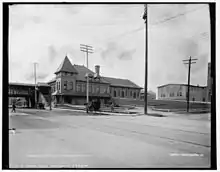
The Rockford Female Seminary became the alma mater of Jane Addams in 1881. This move accompanied the Seminary's transition into a more complete curriculum, which was represented by its renaming to Rockford College in 1892. Culture flourished with the founding of the Mendelssohn Club in 1884, which became the oldest operating music club in the United States. This was complemented by the construction of a Carnegie library in 1902, which became the first building of Rockford's public library system. 1903 saw the dedication of the Winnebago County Veterans Memorial Hall in the presence of sitting President Theodore Roosevelt. Roosevelt returned to Rockford during his campaign in 1912 and again to address the soldiers at Camp Grant, a training site for World War I soldiers.
Twentieth century
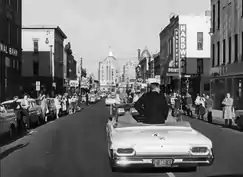
The twentieth century saw demographic changes to Rockford. An influx of Italians, Poles, Lithuanians, and African Americans replaced the previously dominant Irish and Swedes. The city was also no stranger to contemporary political issues. Electorally divided between wets and drys on the subject of prohibition, Rockford featured a coalition of labor unionists and socialists that elected numerous aldermen and carried 25 to 40 percent in mayoral elections. During World War I, an antiwar protest by the Industrial Workers of the World led to 118 arrests. In 1920, the city was a target of the Palmer Raids. While its congressional district favored Republicans, Rockford continuously elected former Socialists as mayor between 1921 and 1955.
One of its contemporary attractions, the Coronado Theatre, opened in 1927. Noted for its atmospheric styling, the Coronado rivaled its counterparts in Chicago and was added to the National Register of Historic Places in 1979.[18] Camp Grant was turned over to the Illinois National Guard. During World War II, it reopened as an induction center and POW detention camp. The USS Rockford, a Tacoma-class frigate named for the city, was commissioned in March 1944 and earned two service stars.
In the September 1949 issue of Life magazine, postwar Rockford was described as "nearly typical of the U.S. as any city can be." Due to this archetypal nature, sociologists like W. Lloyd Warner warned of the necessity to "understand the realities of their system."[19] In the late 1950s, Rockford lost over 50,000 trees to Dutch elm disease, thinning the tree canopy of the "Forest City" for decades.[20]
From 1955 to 1965, several events would take place that would shape the development of Rockford into the 21st century. In 1956, construction was approved for a four-lane U.S 20 bypass;[21] along with shifting truck traffic away from the downtown routing of the highway, the bypass established much of the southern border of the city (which remains to this day). In 1958, Interstate 90 was completed in Illinois, becoming the Northwest Tollway;[21][22] in a decision that would change Rockford forever, the interstate highway was not routed through the city, but near the Winnebago-Boone county line, with the eastern terminus of the US 20 bypass in Cherry Valley.
In 1963, the Rockford area was selected by Chrysler Corporation to construct an assembly plant; the final site of what is now the Belvidere Assembly Plant is southwest of Belvidere, between US 20 and Interstate 90.[21] While not located directly in the city, the Chrysler assembly plant has served as one of the largest employers of the region since its 1965 opening.
The growth of Rockford led to many changes to its educational systems. In 1955, Rockford College (now Rockford University became co-educational for the first time. Coinciding with the expansion of the student body, the college outgrew its near-east side campus in use since the 1840s. Following the acquisition of land in 1957, construction began on its present-day campus location, opening in 1964.[21] In 1964, Rock Valley College was founded as a two-year community college, with construction on its campus commencing in 1965.[21]
Prior to the 1960s, neighborhood and economic growth in Rockford largely mirrored itself on both sides of the Rock River. As the 20th century progressed, growth in western Rockford (and established neighborhoods in eastern areas of the city) struggled to compete with economic development that moved further east. From the late 1950s, downtown Rockford (centered around the intersection of IL 2 and US 20; Main Street and West State Street) began to decline as the primary shopping district of the city. In 1956, North Towne Mall opened on the far northwest side of the city, with Colonial Village opening on the (then) far east side in 1962, both of which were partially enclosed (some stores had exterior entrances).[23] In 1973, Cherryvale Mall was opened as the first fully enclosed shopping mall in the city; nearly 6 miles from the city center, the mall was located at the intersection of the US-20 bypass and the Northwest Tollway, sharing a city border with Cherry Valley.
While growth at the eastern end of Rockford undersaw favorable conditions for growth, established neighborhoods began to suffer irrevocable decline.[24] In the 1970s, efforts commenced to revitalize downtown Rockford, once the primary shopping district. In a highly criticized decision, the city reconfigured several blocks of downtown into a pedestrian mall, closing off the Main Street/West State Street intersection to traffic.[25] In 1975, what the local press characterized as one of the most well-known and haunting crimes[26] took place when newspaper delivery boy Joey Didier was kidnapped and murdered by Robert Lower. In the late 1970s, Symbol, a 47-foot tall Alexander Liberman abstract sculpture was placed in the center of the pedestrian mall.[27] In 1980, then Congressman John B. Anderson, representing the 16th Congressional District in Illinois which includes Rockford, ran for President of the United States. To further attract commercial growth, the MetroCentre 10,000-seat multi-purpose arena, was opened in 1981.
Rockford would be hit hard by the early 1980s recession, becoming one of the highest-unemployed cities in the United States. In 1981, rail service to the city ended as Amtrak ended the Dubuque-to-Chicago Black Hawk route.[28] After struggling to compete with more modern facilities, the Coronado Theatre showed its last movie in 1984, shifting solely to stage performances.[29] To expand passenger service, the Greater Rockford Airport rebuilt its passenger terminal in 1987, although the access of Rockford to the Northwest Tollway (to the much larger O'Hare Airport) became a popular alternative.
In a decision that continues to affect Rockford to the present day, in 1989, Rockford Public School District 205 closed several schools across the city in a cost-cutting decision. In the aftermath of the decision, the school district was found guilty in federal court of discrimination against minority students.[30][31] From 1993 to 2001, the school district was under federal oversight to desegregate its schools, costing over $250 million.[30][31]
Twenty-first century
As with the end of the previous century, the twenty-first century has marked a period of economic challenges for the Rockford region. With its economy predominately based on manufacturing, the city has been affected by the deindustrialization of the Rust Belt.
During the 2000s, a movement began to reverse urban blight of downtown Rockford, which had begun in the 1960s. Following an 18-month multi-million dollar renovation and expansion, the Coronado Theatre was reopened in 2001.[29] In 2008, the MetroCentre downtown arena completed a $20 million renovation (renamed the BMO Harris Bank Center in 2011).[32][33] In 2009, the downtown pedestrian mall was removed as part of a street refurbishment project, restoring Main Street (Illinois Route 2) to two-lane traffic for the first time in nearly 45 years.[25]
Prior to the onset of the Great Recession, housing in Rockford was affected by catastrophic weather events. In 2006 and 2007, Keith Creek underwent 100-year flooding events, damaging hundreds of older homes on the near east side of the city. In response, the city secured FEMA grants, demolishing over 100 homes; to reduce the severity of future flooding events, the creek is being reconstructed (through 2019) and left as greenspace.[34][35][36] As an effect of the recession, by 2013, thirty-two percent of mortgages in the city were upside-down.[37] While remaining the largest city in Illinois outside Chicago and its suburbs, estimated population decline from 2010 to 2017 led Rockford to be overtaken by Joliet and Naperville (the latter, slightly), effectively making it the fifth-largest city in Illinois.[10]
From 2014 to 2018, the unemployment rate in Rockford has fallen from 12.9 percent to 4.4 percent (the lowest since 2000).[38][39] While predominately a manufacturing community since World War II, Rockford has struggled to diversify its industrial base. Shifting from agricultural machinery and furniture, manufacturing in the city remains dominated by fasteners, automotive suppliers (representing FCA Belvidere Assembly), and the aerospace industry (Woodward and Collins Aerospace; the latter, tracing its roots to Sundstrand Corporation). In 2012, Woodward selected suburban Loves Park for a $200 million manufacturing campus toward its energy control and optimization systems.[40] Boeing included Rockford in a list of five finalists to manufacture the 777X during union disputes in 2014.[41] In 2016, AAR Corporation opened a MRO facility at the Rockford airport with a hangar large enough to fit a Boeing 747-8.
During the 2010s, all three major health care providers in Rockford underwent major expansions of their facilities. SwedishAmerican, in partnership with the University of Wisconsin Carbone Cancer Center, opened a $39 million Regional Cancer Center in 2013.[42] In 2014, MercyHealth (based in Janesville, Wisconsin) acquired Rockford Health System, the operator of Rockford Memorial Hospital. In 2019, MercyHealth opened Javon Bea Hospital-Riverside (named after the MercyHealth CEO and its Riverside Boulevard/Interstate 90 location); its second hospital in Rockford, the $505 million complex was the largest construction project in the history of the city.[43][44][45]
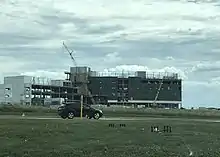
Geography
According to the 2010 census, Rockford has an area of 61.949 square miles (160.45 km2), of which 61.08 square miles (158.20 km2) (or 98.6%) is land and 0.869 square miles (2.25 km2) (or 1.4%) is water.[46] Neighboring communities that border Rockford, and are considered an integral part of the Rockford metro area, are the cities of Loves Park, Machesney Park, Belvidere, and the villages of Winnebago, Roscoe, Rockton, Poplar Grove, New Milford, and Cherry Valley.
Also of note, South Beloit, Illinois and Beloit, Wisconsin are part of this continuous urban area that stretches for approximately 30 miles along the Rock River from the Chicago Rockford International Airport north to the Southern Wisconsin Regional Airport. Rockford is approximately 85 miles west-northwest of downtown Chicago, and 70 miles south-southeast of Madison.
Waterways

The Rock River forms the traditional center of Rockford and is its most recognizable natural feature. One of its largest tributaries, the Kishwaukee River, joins the Rock River at the southern end of the city near the Rockford airport. Since the 1946 closure of Camp Grant, much of the length of Kishwaukee has been redeveloped into parkland and forest preserves, effectively forming the southern border of the city. Other waterways that feed into the Rock River include Spring Creek (northeast region), Keith Creek (east region), and Kent Creek (west region). Of the 8 Illinois dams of the Rock River, the Fordham dam is located south of downtown.
Climate
Due to its location in the Midwest, naturally a deciduous forest, Rockford's climate has four clearly defined seasons. Summers are usually hot and humid with the average high temperature in July (the hottest month) being 84.5 °F (29.2 °C). The winter months can bring bitterly cold Arctic air masses. The average high temperature in January (the coldest month) is 29.5 °F (−1.4 °C). June is Rockford's wettest month while January is the driest. During a typical year, Rockford receives 36.2 in (920 mm) of precipitation.
Rockford and surrounding areas are prone to violent thunderstorms during March, April, May, and June. On April 21, 1967, a violent F4 tornado struck the neighboring town of Belvidere, killing twenty-four people and injuring hundreds more at Belvidere's High School. Other severe weather events, such as hail and strong winds are common in these storms. On July 5, 2003 at 04:13, a line of severe storms and their associated high winds caused widespread damage on both the east and west sides of Rockford.[47] Approximately 70,000 people were without power, with many on the west side suffering in the heat without electricity for a week. It took months to clear the damage, but because the storm struck so early in the morning there were no injuries or fatalities. However, these sometimes violent storms bring the majority of summer rainfall.
The city is also prone to severe snowstorms in winter, and blizzards are frequent winter occurrences. On January 13, 1979 over 9 inches (23 cm) of snow fell on Rockford in just a few hours during one of the strongest blizzards in the city's history. The city averages approximately 36 inches (91.4 cm) of snowfall in a normal winter, but greater amounts are common. The snowiest winter in the history of the city was the winter of 1978–1979, when 74.5 inches (189 cm) of snow fell.
The record high temperature is 112 °F (44 °C), set on July 14, 1936 during the Dust Bowl,[48] and the record low temperature is −31 °F (−35 °C), set on January 31, 2019.[49]
| Climate data for Rockford, Illinois (Chicago Rockford International Airport), 1981−2010 normals & extremes | |||||||||||||
|---|---|---|---|---|---|---|---|---|---|---|---|---|---|
| Month | Jan | Feb | Mar | Apr | May | Jun | Jul | Aug | Sep | Oct | Nov | Dec | Year |
| Record high °F (°C) | 63 (17) |
70 (21) |
85 (29) |
93 (34) |
106 (41) |
106 (41) |
112 (44) |
104 (40) |
103 (39) |
91 (33) |
81 (27) |
69 (21) |
112 (44) |
| Mean maximum °F (°C) | 48.9 (9.4) |
53.1 (11.7) |
71.3 (21.8) |
81.6 (27.6) |
86.8 (30.4) |
92.6 (33.7) |
93.6 (34.2) |
92.7 (33.7) |
89.1 (31.7) |
81.1 (27.3) |
66.8 (19.3) |
51.8 (11.0) |
95.7 (35.4) |
| Average high °F (°C) | 29.5 (−1.4) |
34.2 (1.2) |
46.9 (8.3) |
60.7 (15.9) |
71.8 (22.1) |
81.1 (27.3) |
84.5 (29.2) |
82.4 (28.0) |
75.4 (24.1) |
62.7 (17.1) |
47.6 (8.7) |
33.2 (0.7) |
59.3 (15.2) |
| Average low °F (°C) | 13.5 (−10.3) |
17.7 (−7.9) |
27.5 (−2.5) |
38.1 (3.4) |
48.4 (9.1) |
58.5 (14.7) |
63.0 (17.2) |
61.3 (16.3) |
52.4 (11.3) |
40.7 (4.8) |
30.3 (−0.9) |
17.7 (−7.9) |
39.2 (4.0) |
| Mean minimum °F (°C) | −10.6 (−23.7) |
−4.4 (−20.2) |
8.8 (−12.9) |
21.6 (−5.8) |
33.6 (0.9) |
44.8 (7.1) |
51.5 (10.8) |
49.9 (9.9) |
36.0 (2.2) |
25.4 (−3.7) |
13.7 (−10.2) |
−4.5 (−20.3) |
−15.3 (−26.3) |
| Record low °F (°C) | −31 (−35) |
−25 (−32) |
−11 (−24) |
5 (−15) |
24 (−4) |
35 (2) |
43 (6) |
35 (2) |
24 (−4) |
7 (−14) |
−10 (−23) |
−24 (−31) |
−31 (−35) |
| Average precipitation inches (mm) | 1.37 (35) |
1.41 (36) |
2.32 (59) |
3.35 (85) |
4.02 (102) |
4.65 (118) |
3.95 (100) |
4.59 (117) |
3.35 (85) |
2.67 (68) |
2.58 (66) |
1.98 (50) |
36.24 (921) |
| Average snowfall inches (cm) | 10.2 (26) |
7.7 (20) |
4.8 (12) |
0.9 (2.3) |
trace | 0 (0) |
0 (0) |
0 (0) |
0 (0) |
0.1 (0.25) |
1.7 (4.3) |
11.3 (29) |
36.7 (93) |
| Average precipitation days (≥ 0.01 in) | 9.4 | 8.2 | 10.5 | 11.3 | 12.2 | 10.4 | 9.4 | 9.7 | 8.3 | 9.4 | 10.2 | 10.2 | 119.2 |
| Average snowy days (≥ 0.1 in) | 8.2 | 5.8 | 4.1 | 1.0 | 0 | 0 | 0 | 0 | 0 | 0.1 | 1.8 | 7.7 | 28.7 |
| Source: NOAA (extremes 1893–present)[50][51] | |||||||||||||
Demographics
| Historical population | |||
|---|---|---|---|
| Census | Pop. | %± | |
| 1860 | 6,979 | — | |
| 1870 | 11,049 | 58.3% | |
| 1880 | 13,120 | 18.7% | |
| 1890 | 23,584 | 79.8% | |
| 1900 | 31,051 | 31.7% | |
| 1910 | 45,401 | 46.2% | |
| 1920 | 64,651 | 42.4% | |
| 1930 | 85,864 | 32.8% | |
| 1940 | 84,637 | −1.4% | |
| 1950 | 92,927 | 9.8% | |
| 1960 | 126,706 | 36.4% | |
| 1970 | 147,370 | 16.3% | |
| 1980 | 139,712 | −5.2% | |
| 1990 | 139,426 | −0.2% | |
| 2000 | 150,115 | 7.7% | |
| 2010 | 152,871 | 1.8% | |
| 2019 (est.) | 145,609 | [6] | −4.8% |
| [5][52] | |||
As of the 2010 census,[53] there were 152,871 people and 66,700 households. Rockford is in the center of its namesake metropolitan area. The racial makeup of the city was 65.1% White (58.4% Non-Hispanic white), 20.5% African American, 0.4% Native American, 2.9% Asian, 0.01% Pacific Islander, 7.5% from other races, and 3.6% from two or more races. Hispanic or Latino of any race were 15.8% of the population.[54]
The median income for a household in the city was $55,667, and the median income for a family was $65,465. Males had a median income of $37,098 versus $25,421 for females. The per capita income for the city was $19,781. 14.0% of the population and 10.5% of families were below the poverty line. 19.6% of those under the age of 18 and 8.0% of those 65 and older were living below the poverty line.
In the late 1950s, Rockford surpassed Peoria as the second largest city in Illinois by population, holding onto that position into the 21st century. In 2003, the status was changed as it was overtaken by Aurora after the results of a special census held by the latter city (as the two cities were not counted together, a direct comparison was not possible until the national census in 2010).
Religion
Like many other Rust Belt and midwestern cities, Catholics make up Rockford's largest religious group. According to 2010 figures, 20% of Winnebago County residents are Catholic, 19% are Evangelical, 10% are Mainline Protestant and 48% belong to a non-listed faith or have no religion.[55] The Roman Catholic Diocese of Rockford, several large evangelical and non-denominational churches, and several Lutheran and other Mainline Protestant congregations serve Rockford's Christian community. Rockford's Jewish community is served by a synagogue, the Muslim community by a mosque, the Sikhs by a temple, and its Buddhist community is served by two houses of worship.[56][57]
Law and government
| Rockford, Illinois | |
|---|---|
| Crime rates* (2013) | |
| Violent crimes | |
| Homicide | 7.5 |
| Rape | 57.7 |
| Robbery | 132.5 |
| Aggravated assault | 513.3 |
| Total violent crime | 711.1 |
| Property crimes | |
| Burglary | 789.7 |
| Larceny-theft | 2055.6 |
| Motor vehicle theft | 145.0 |
| Total property crime | 2990.4 |
Notes *Number of reported crimes per 100,000 population. Source: 2013 FBI UCR Data | |
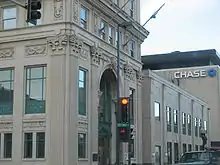
Since the creation of Winnebago County in 1836, Rockford has served as its county seat. Rockford is the largest Dillon's Rule municipality in Illinois, having revoked home rule in 1983. Along with a mayor (elected every four years), the Rockford City Council consists of 14 alderman (elected every 4 years), with the city divided into 14 wards.
In a fashion similar to other cities its size (or larger), local government is split into executive and legislative branches. The mayor of Rockford is chosen in a general election every four years. The Rockford City Council consists of 14 aldermen, individually elected from each ward in the city. The City Council, as of May 2017, consists of:[58]
| Office | Office holder |
|---|---|
| Mayor | Thomas McNamara (D) |
| Alderman - 1st Ward | Tim Durkee (R) |
| Alderman - 2nd Ward | Johnathan K. Logemann (D) |
| Alderman - 3rd Ward | Chad Tuneberg (R) |
| Alderman - 4th Ward | Kevin Frost (R) |
| Alderman - 5th Ward | Venita Hervey (D) |
| Alderman - 6th Ward | Natavias Ervins (D) |
| Alderman - 7th Ward | Ann Thompson-Kelly (D) |
| Alderman - 8th Ward | Karen Hoffman (D) |
| Alderman - 9th Ward | Bill Rose (D) |
| Alderman - 10th Ward | Frank Beach (R) |
| Alderman - 11th Ward | Tuffy Quinonez (D) |
| Alderman - 12th Ward | John Beck (R) |
| Alderman - 13th Ward | Linda McNeely (D) |
| Alderman - 14th Ward | Joseph Chiarelli (R) |
Township
In contrast to other large cities in Illinois, Rockford is within a single township. By area and population, Rockford Township is the largest township in Illinois. Operating separately from the city of Rockford, the township performs civil services for several unincorporated areas of the city, as well as for other areas of the township outside of city limits.
Economy
Largest employers
As of January 2017,[59] the ten largest employers in Rockford, Illinois are:
| Rank | Company/organization name | # of employees |
|---|---|---|
| 1 | Fiat Chrysler Automobiles (Belvidere Assembly Plant) | 4,323 |
| 2 | Rockford Public School District 205 | 3,525 |
| 3 | Mercy Health | 3,195 |
| 4 | SwedishAmerican Health System | 2,988 |
| 5 | OSF Healthcare | 2,800 |
| 6 | Collins Aerospace | 2,200 |
| 7 | Walmart Stores | 1,611 |
| 8 | Woodward, Inc. | 1,540 |
| 9 | PCI - Packaging Coordinators, Inc. | 1,500 |
| 10 | Winnebago County | 1,449 |
Other industry
Mrs. Fisher's, also known as Mrs. Fishers Potato Chips, a regional manufacturer of potato chips founded in Rockford, is a recognized brand name of potato chips in parts of the Midwestern United States. Since 1923, Rockford has been home to Kegel Harley-Davidson; owned by the same family since 1912, it is the oldest family-owned Harley-Davidson franchise in existence.[60]
Transportation
Roads and highways
By highway, Rockford is linked by highway to Wisconsin (Madison, Milwaukee), Iowa (Dubuque), and many parts of Illinois. In the past 30 years, the centralized location of the region has worked to an advantage in attracting jobs the logistics and transportation industries.
Public transportation in the city is provided by the Rockford Mass Transit District (RMTD).
- Interstate 90
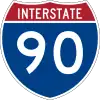
- Known as the Northwest Tollway before 2007, the Jane Addams Memorial Tollway links the city to Madison, Wisconsin and the northwest Chicago suburbs. From Rockford north, I-90 replaces U.S. Route 51 in Illinois. I-90 also links the city with Milwaukee, Wisconsin, as I-43 joins it 2 miles north of the state line.
- Originally placed several miles east of the city, the Northwest Tollway would play a role in the rapid growth of the eastern half of Rockford in the later 20th century.
- U.S. Route 20

- U.S. Route 20 travels through Rockford twice. The city also marks the point where the highway and Interstate 90 no longer parallel each other travelling westward. The original highway is marked as a four to six-lane east-west business route (State Street) that divides the city to the north and south. From the 1970s to the late 1990s, the road played a key role in commercial development to the city.
- In 1965, a four-lane US 20 freeway bypass was completed. Starting from Northwest Tollway near Cherry Valley, the bypass traveled alongside the southern end of the city, joining the business route approximately two miles west of the city limits. From the west, US 20 (also known as the Grant Memorial Highway) provides a link to Freeport, Galena, and Dubuque, Iowa. Much of the highway west of Freeport is a winding two-lane road that discourages truck traffic. To the east, US 20 roughly parallels Interstate 90, becoming a major central thoroughfare in several Chicago suburbs.
- The US 20 bypass intersects with Illinois 251 (formerly US 51); it also forms the northern terminus of the Illinois segment of Interstate 39. Both highways are then concurrent eastward to Interstate 90, where the bypass ends.
- Interstate 39
 and U.S. Route 51
and U.S. Route 51 
- U.S. Route 51 travels through Rockford twice; the original alignment of the highway is now renamed Illinois Route 251. Entering through southeast Rockford through New Milford, Route 251 travels through the eastern half of the city among several major surface streets; as it exits Rockford, Route 251 serves as the primary north-south thoroughfare from Loves Park to South Beloit.
- During the late 1970s and early 1980s, the original Route 51 was replaced by the construction of Interstate 39, which adopted the alignment of the previous two-lane highway. Directly connecting Rockford to Bloomington-Normal, Interstate 39 also gives interstate access to Peoria and the Quad Cities; with access to Interstate 80 and Interstate 88, Interstate 39 allows for Rockford access to the southern suburbs of Chicago, also indirectly serving as a bypass around the city to Wisconsin.
- Other roads/highways
 Illinois Route 2 (South/North Main Street)
Illinois Route 2 (South/North Main Street) Illinois Route 70 (Kilburn Avenue)
Illinois Route 70 (Kilburn Avenue) Illinois Route 251 (North Second Street, Kishwaukee Street, Harrison Avenue, 11th Street)
Illinois Route 251 (North Second Street, Kishwaukee Street, Harrison Avenue, 11th Street)- Raoul Wallenberg Expressway (proposed, never built)
- The Veterans Memorial Beltway consists of four-lane surface roads that create a continuous outer loop around the city. The roads that make up the beltway include Perryville Road, Harrison Avenue, Springfield Avenue, and Riverside Boulevard.
Bus
The Rockford Mass Transit District (RMTD) provides fixed-route and paratransit service, with a service area including Rockford, Loves Park, and Machesney Park. The 40 fixed route buses operate over 17 routes Monday thru Saturday, 6 night routes and 5 routes on Sundays.[61]
Bicycle-sharing system
In April 2018, Rockford became included in the LimeBike bicycle-sharing network.[62] Using 500 commuter bicycles supplied by the company, residents rent bicycles through a mobile app, unlocking the dockless bicycles.[63] Distinguished by their bright green color, LimeBikes are equipped with a basket, lights, and GPS (to locate them for rental); one-speed and three-speed units are in use.[63] In early 2019, LimeBike was discontinued in Rockford.
Air
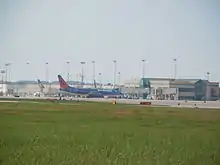
In 1946, after Camp Grant closed, the state of Illinois allowed for the establishment of an airport to serve Rockford. Built on the portion of the Camp Grant property between the Rock River and US 51 (now Illinois 251), the Greater Rockford Airport was between the southern border of Rockford and New Milford. Opened in 1946, the Greater Rockford Airport opened its current passenger terminal in 1987. In 1994, United Parcel Service (UPS) opened the first of its two facilities at the airport; Rockford is home to the second-largest UPS air package operation (after Worldport in Louisville, Kentucky).
In 2016, Amazon Air began operating multiple daily cargo flights at its own facility at the airport, partnering with ATI, ABX and Atlas Air.[64][65]
Following the loss of passenger service at the airport from 2001 to 2003, the Greater Rockford Airport underwent several name changes, becoming the Chicago Rockford International Airport in 2007. Since the restoration of passenger service in 2003, the Rockford airport primarily markets its passenger service for leisure travelers, offering flights by Allegiant Air along with charter operations on a seasonal basis.
Machesney Airport, located north of the city, was opened in 1927 as a private airport serving the Rockford area. During World War II, the airport was utilized by the Army Air Corps. After the war, it again served as municipal airport, closing in 1974. After its closure, the Machesney Airport became the site of the Machesney Park Mall, built in 1980.
Rail
- Passenger
As of 2019, the Rockford region is not served by passenger rail service. From 1974 to 1981, Rockford was served by Amtrak via its Black Hawk route, a daily train service from Dubuque, Iowa to Union Station in Chicago with a stop in Rockford. The Black Hawk was discontinued in September 1981 as part of funding cuts to Amtrak.
During the 2000s, interest increased in relinking the Rockford and Chicago regions by rail. In 2006, the Northern Illinois Commuter Transportation Initiative proposed extending Metra train service from the western Chicago suburbs to Rockford.[66] While Metra service has yet to be proposed on an official level, during the early 2010s, there was design work on a planned 2015 revival of the Black Hawk route on Canadian National rails.,[67] with Rockford as the initial terminus. As part of the ongoing Illinois financial crisis, state funding for the Black Hawk revival was suspended in February 2015, putting the project on hold.[68]
- Freight
Rockford is served by several different freight railroad lines, the Union Pacific, the Canadian National, the Iowa, Chicago & Eastern (Canadian Pacific), and the Illinois Railway. The Union Pacific line from West Chicago terminates in Rockford, at a small yard. Canadian National line from Elgin enters from the South-East, and leaves in the North-West. They have a small yard, where they interchange with the Illinois Railway. The Illinois Railway Rockford Line comes from the South, joins the Canadian National line, where they continue on trackage rights to the Canadian National yard. Canadian Pacific (Iowa, Chicago, and Eastern) runs on Illinois Railway trackage rights from Davis Junction, and leaves on their own trackage to the North. All of the railroads interchange at a yard off of Main Street. The Union Pacific Railroad's Global III Intermodal Facility is approximately 25 miles (40 km) south of Rockford in Rochelle, Illinois, a community of 10,000. The complex is one of the world's largest intermodal facilities. Construction on the state-of-the-art facility was completed in 2003 in Rochelle due to the close proximity to four interstate highways (I-39, I-88, I-80, and I-90) and rail routes.
Education
Post-secondary
Although Rockford is in a large metropolitan area, the region does not have any public 4-year universities; the closest such institution is Northern Illinois University in DeKalb, 45 miles (72 km) away. Along with Rockford University (a private 4-year school of just under 2000 students), the city is the home to Rock Valley College (a 10,000-student community college), Rockford Business College (re-branded as Rockford Career College in 2009), and St. Anthony College of Nursing.
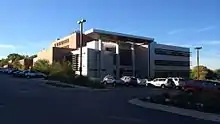
In addition, it hosts several satellite branches of other schools, including Judson University (based in Elgin), Northern Illinois University (based in DeKalb), Rasmussen College,[69] Embry–Riddle Aeronautical University as a part of their "worldwide campus",[70] and the University of Illinois College of Medicine (based in Chicago).
Rockford University is best known for graduating Jane Addams, recipient of the Nobel Peace Prize in 1931 for her efforts to promote international peace and justice. Laura Jane Addams (1860–1935) entered what was then Rockford Female Seminary in 1877 and became the first graduate to receive a B.A. degree from the newly accredited baccalaureate institution in 1882 (the school was renamed Rockford College in 1892, and Rockford University in 2013).
Rock Valley College is a community college with several locations in the Rockford area. The main campus is the site of the Bengt Sjostrom Theatre. The former outdoor theatre now features a motorized retractable roof constructed during 2003.[71]
Public School District 205
Serving Rockford, Cherry Valley, and portions of Winnebago and Boone counties, Rockford Public School District 205 covers an area of roughly 170 square miles (440 km2). With approximately 27,000 students, it is the state's fourth-largest school district by enrollment. District 205 has four high schools (Auburn, East, Guilford, and Jefferson), six middle schools, and 29 elementary schools. It also operates early-childhood and alternative education centers. Beginning with the class of 2021, graduates of the Rockford Public Schools and residents within the city of Rockford with a cumulative 3.0 GPA can attend Northern Illinois University tuition free. This location-based scholarship program is a partnership between Rockford Public Schools, Northern Illinois University, Rockford Promise and the city of Rockford.[72]
Private schools
In addition to its public school system, Rockford supports 27 sectarian and nonsectarian private schools ranging from elementary to secondary education.
Culture and tourism

The attractions of Rockford are often of architectural significance. The Lake-Peterson House, constructed by alderman John Lake in 1873 and preserved by Swedish industrialist Pehr August Peterson, is a notable example of Gothic Revival. Added to the National Register of Historic Places in 1980, it is used for the School of Medical Technology of the Rockford-based Swedish American Hospital.[73]
Further Swedish influence on Rockford during the Victorian era is represented in the Erlander Home Museum, the base of the Swedish Historical Society. Swiss influence can be seen in the Tinker Swiss Cottage, which was opened as a museum under the park district in 1943 and was featured in an episode of Ghost Hunters in 2012.[74][75]
Modern architectural movements, like Art Deco and Prairie School, are also integral to Rockford. Most renowned is the Coronado Theatre, a civic and entertainment center named one of 150 Great Places in Illinois by the American Institute of Architects. The theatre is known for its blend of Art Deco with Spanish Baroque Revival and has hosted numerous performers over its lifetime, including the Marx Brothers, Frank Sinatra, and Bob Dylan.[76][77] The 186-foot tall Faust Hotel complements the Coronado; constructed in 1929, it endures as Rockford's tallest building, albeit as apartments for the elderly and disabled. The Laurent House, a single-story Usonian home constructed in 1952 by Frank Lloyd Wright, is the only Wright building designed for a person with disabilities. Acquired by a private foundation from its commissioners, it was renovated into a museum in 2014.[78] The Rockford Area has two additional places named by the American Institute of Architects in the 150 Great Places, Anderson Japanese Gardens in Rockford, Illinois and Poplar Grove United Methodist Church in Poplar Grove, Illinois.

The area is often regarded as an outdoor destination. Rock Cut State Park is to the northeast of the city. Once home to various Scots, Canadians, and New Englanders, as well as a railroad line to Kenosha, the park's 3,092 acres are now utilized for camping, hiking, fishing and boating, and hunting.[79] Anderson Japanese Gardens, modeled after the Portland Japanese Garden and landscaped by Hoichi Kurisu, is 10 acres in size and features a teahouse and guesthouse in the sukiya-zukuri style. John Anderson, the commissioner of the gardens, was presented with a commemorative silver cup by Japan for his efforts in the mutual understanding of cultures in 1992; he donated the gardens to a nonprofit organization later in 1998.[80] Klehm Arboretum and Botanic Garden is 155 acres in size and is noted for its selection of both indigenous and foreign plant species.[81]

More recently, Experience Based Learning opened a Zip-line attraction, as its founder (Steve Gustafson) is a Rockford native.
The park district of Rockford (Rockford Park District) is particularly active. It operates Aldeen Golf Course, which was rated the best municipal golf course in Illinois by Golf Digest and one of the top fifty golf courses in the nation that cost under $50 to play by Golf Magazine.[83] In addition to Tinker Swiss Cottage, the park district maintains four other museums. The Burpee Museum of Natural History is home to the world's most complete juvenile Tyrannosaurus rex, Jane, as well as a triceratops, Homer. The Discovery Center Museum, a children's museum featuring over 250 hands-on exhibits including a planetarium, is on the 12 Best Children's Museums In The U.S. list by Forbes.[84] The Burpee Museum and the Discovery Center Museum, along with the Rockford Art Museum and the bases for Northern Public Radio, the Rockford Dance Company, and the Rockford Symphony Orchestra compose the downtown Riverfront Museum Park complex. The last museum under the park district's authority is Midway Village and Museum Center, a recreation of a Victorian era village. The eastern riverwalk of Rockford is maintained by the park district, featuring the Nicholas Conservatory and Garden., Located on the bank of the Rock River, the conservatory is the third-largest in the state of Illinois. Just north of the gardens is Symbol, an Alexander Liberman sculpture moved from downtown during the 1980s and is now one of Rockford's most recognizable features.[85]
Notable people
Sports teams
Current
- Rockford IceHogs (ice hockey; UHL 1999–2007, AHL 2007–present)
- Rockford Rivets (baseball; NWL 2015–present)
- Rockford Rage (women's roller derby; 2006–present)[86]
- Rockford Raptors (indoor football)
Historical
- Rockford Forest Citys (baseball, 1871)
- Rockford Peaches (women's baseball; AAGPBL, 1943–1954)
- Rockford Lightning (basketball; CBA, 1986–2005)
- Rockford Aviators (baseball; Frontier League 2002–2009, Northern League 2010, Frontier League 2011–2015)[87]
- Rockford Rampage (indoor soccer; AISL 2005–2008, NISL 2008-2010)
- Rockford Fury (basketball; PBL, 2006–2008)
- Rockford Foresters (baseball; Midwest Collegiate League 2010–2013)
Rockford Peaches
From 1943 to 1954, the Rockford Peaches were an inaugural team of the All-American Girls Professional Baseball League. Playing home games at Beyer Stadium, the Peaches won league championships in 1945, 1948, 1949, and 1950; the four championships are the most of any league member.
The Rockford Peaches and the league itself were portrayed in the 1992 motion picture A League of Their Own. However, the characters in the film are fictional; the Peaches did not compete for the 1943 league championship (as depicted in the film). Since Beyer Stadium was demolished by the time of filming, the city of Rockford was not featured in production.
Surrounding communities and suburbs
Sister cities
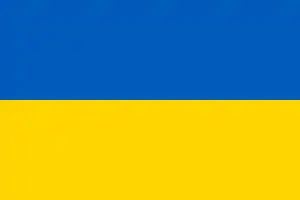 Brovary, Kiev Oblast, Ukraine [88] since 1995
Brovary, Kiev Oblast, Ukraine [88] since 1995 Changzhou, Jiangsu, China since 1999
Changzhou, Jiangsu, China since 1999 Borgholm, Sweden[88] since 2002
Borgholm, Sweden[88] since 2002 Cluj-Napoca, Romania[88] since 2005
Cluj-Napoca, Romania[88] since 2005 Ferentino, Lazio, Italy[88] since 2006
Ferentino, Lazio, Italy[88] since 2006 Tokmok, Kyrgyzstan[88]
Tokmok, Kyrgyzstan[88] Taszár, Hungary[88]
Taszár, Hungary[88]
City of Lidköping & County of Skaraborg, Sweden, is Rockford's Industrial Partnership Agreement city. The two regions work together with growing locally by working globally
Media
Rockford is the 161st largest radio market in the United States.[89] It is ranked 136th by Nielsen Media Research for the 2015-2016 television season with 170,140 television households.[90]
The area is served by over 15 commercial radio stations, over 5 non-commercial radio stations, 2 low power FM radio stations, 5 TV stations and 1 daily newspaper.
See also
References
- Whittaker, Wayne (1956). The Rockford story: 1852-1952. University of Illinois Urbana-Champaign. [Rockford, Ill.: Rockford Chamber of Commerce].
- Whittaker, Wayne (1956). The Rockford story: 1852-1952. University of Illinois Urbana-Champaign. [Rockford, Ill.: Rockford Chamber of Commerce].
- "Archived copy" (PDF). Archived from the original (PDF) on June 2, 2016. Retrieved May 13, 2016.CS1 maint: archived copy as title (link)
- "2019 U.S. Gazetteer Files". United States Census Bureau. Retrieved July 14, 2020.
- "Rockford (city), Illinois". State & County QuickFacts. U.S. Census Bureau. July 8, 2014. Retrieved September 15, 2014.
- "Population and Housing Unit Estimates". Retrieved May 21, 2020.
- "City of Rockford". Geographic Names Information System. United States Geological Survey.
- "Annual Estimates of the Resident Population for Incorporated Places of 50,000 or More, Ranked by July 1, 2013 Population: April 1, 2010 to July 1, 2013". U.S. Census Bureau, Population Division. May 2014. Archived from the original on February 12, 2020. Retrieved September 16, 2014.
- https://www.census.gov/quickfacts/fact/table/rockfordcityillinois/LND110210
- "U.S. Census Bureau QuickFacts: Rockford city, Illinois". Census Bureau QuickFacts. Retrieved November 1, 2018.
- "Dictionary and Thesaurus - Merriam-Webster". Retrieved July 4, 2016.
- "Rockford - Illinois, United States". Retrieved July 4, 2016.
- Bridget, French. "All About Rockford, Illinois" (PDF). Rockford Area Convention & Visitors Bureau. Rockford Area Convention & Visitors Bureau. Archived from the original (PDF) on September 4, 2015. Retrieved June 27, 2014.
- History of Rockford and Winnebago County, Illinois: From the First Settlement in 1834 to the Civil War pg. 253
- The Expansion of New England: The Spread of New England Settlement and Institutions to the Mississippi River, 1620-1865 by Lois imball Mathews pg. 210-212
- History of Rockford and Winnebago County, Illinois: From the First Settlement in 1834 to the Civil War, pg. 379
- Lundin, Jon W. "Rockford, An Illustrated History, Windsor Publications 1989 p. 8
- Krefft, Bryan. "Coronado Performing Arts Center". Cinema Treasures. Cinema Treasures. Retrieved June 27, 2014.
- Warner, W. Lloyd (September 12, 1949). "A sociologist looks at an American community". Life Magazine. Life Magazine. pp. 108–119.
- Services, DNC Web. "tidbits". RockfordReminisce.com. Retrieved April 23, 2019.
- Services, DNC Web. "timeline". RockfordReminisce.com. Retrieved April 23, 2019.
- "TIMELINE OF ROCKFORD'S HISTORY" (PDF). Midway Village.
- http://mall-hall-of-fame.blogspot.com/2009/10/cherryvale-mall-harrison-avenue-and.html Also see Cherryvale Mall confirming assertion
- Lundin, Jon W. "Rockford, An Illustrated History, Windsor Publications 1989 p. 12
- Kolkey, Jeff (December 11, 2008). "Goodbye, pedestrian mall: Downtown gets a 'cool, hip image'". Rockford Register Star. Rockford Register Star. Retrieved June 26, 2014.
- https://www.wifr.com/content/news/Man-convicted-of-1975-murder-dies-in-prison-414542893.html
- Schwitters, Kevin. "Historical Facts About Symbol". Symbol—The Official Rockford Sculpture. Kevin Schwitters. Retrieved June 27, 2014.
- Hilkevitch, Jon (April 10, 2014). "Amtrak rail service between Chicago and Rockford to begin in 2015". Chicago Tribune. Chicago Tribune. Retrieved June 26, 2014.
- "About Coronado Performing Arts Center". Coronado Performing Arts Center. Coronado PAC. Retrieved June 27, 2014.
- Curry, Corina (February 24, 2009). "People Who Care: It all began 20 years ago". Rockford Register Star. Rockford Register Star. Retrieved June 27, 2014.
- "Segregated Again - But Equal?". Segregated Again. Retrieved April 23, 2019.
- Wiser, Mike (July 11, 2008). "MetroCentre revamp project winding down, revenue going up". Rockford Register Star. Rockford Register Star. Retrieved June 26, 2014.
- Kolkey, Jeff (August 11, 2011). "Rockford MetroCentre has new name: BMO Harris Bank Center". Rockford Register Star. Rockford Register Star. Retrieved June 26, 2014.
- Kolkey, Jeff (October 9, 2009). "Keith Creek home demolition to start soon". Rockford Register Star. Rockford Register Star. Retrieved June 28, 2014.
- Green, Chris (December 13, 2013). "An empowered Rockford neighborhood celebrates accomplishments". Rockford Register Star. Rockford Register Star. Retrieved June 28, 2014.
- "2019-2023 CAPITAL IMPROVEMENT PROGRAM" (PDF). City of Rockford (IL). p. 17.
- Dougherty, Conor (September 8, 2013). "Welcome to Rockford, Ill, the Underwater Mortgage Capital of America". The Wall Street Journal. The Wall Street Journal. Retrieved June 26, 2013.
- "Economy at a Glance". Bureau of Labor Statistics. Bureau of Labor Statistics. June 20, 2014. Retrieved June 26, 2014.
- Kolkey, Jeff (June 21, 2018). "Unemployment falls across Rockford region". Rockford Register Star. Rockford Register Star. Retrieved August 15, 2018.
- Gary, Alex (August 23, 2012). "Woodward picks Loves Park for $200M expansion". Rockford Register Star. Rockford Register Star. Retrieved June 28, 2014.
- Karp, Gregory (January 9, 2014). "Illinois had shot to land 777X plant". Chicago Tribune. Chicago Tribune. Retrieved June 28, 2014.
- Westphal, Melissa (October 9, 2013). "New SwedishAmerican cancer center opens next week in Rockford". Rockford Register Star. Rockford Register Star. Retrieved June 28, 2014.
- Leaf, Brian (March 2, 2016). "Negotiations continue as city tries to keep MercyRockford from moving $485M project to Wisconsin". Rockford Register Star. Rockford Register Star. Retrieved August 15, 2018.
- "Mercyhealth breaks ground on $485 million women's and children's hospital in Rockford". Mercy Health. June 6, 2016. Retrieved August 15, 2018.
- Green, Chris (September 28, 2017). "Construction on pace for new Mercyhealth hospital". Rockford Register Star. Rockford Register Star. Retrieved August 15, 2018.
- "G001 - Geographic Identifiers - 2010 Census Summary File 1". United States Census Bureau. Archived from the original on February 13, 2020. Retrieved December 27, 2015.
- "Damaging Winds at Rockford and Around Chicagoland". National Weather Service. 2003.
- "July Daily Averages for Rockford, IL". The Weather Channel. February 27, 2012.
- "Historic Record Cold Temperatures Across Northern Illinois". The Weather Channel. February 27, 2012.
- "NowData - NOAA Online Weather Data". National Oceanic and Atmospheric Administration. Retrieved June 27, 2016.
- "Station Name: IL ROCKFORD GTR ROCKFORD AP". National Climatic Data Center. Retrieved June 27, 2016.
- "Census of Population and Housing". U.S. Census Bureau. Retrieved September 15, 2014.
- "U.S. Census website". United States Census Bureau. Retrieved January 31, 2008.
- "Race, Hispanic or Latino, Age, and Housing Occupancy: 2010". U.S. Census Bureau. Retrieved October 1, 2011.
- "The Association of Religious Data Archives". www.thearda.com. Retrieved June 29, 2014.
- "Community Directory". Jewish Federation of Greater Rockford. Archived from the original on November 13, 2014. Retrieved June 29, 2014.
- Vela, Susan. "Rock River Valley's Laotians Celebrate New Year". RRstar.com. Rockford Register Star. Retrieved June 29, 2014.
- "Wards and Aldermen". The City of Rockford. Archived from the original on April 11, 2016. Retrieved April 12, 2016.
- "CITY OF ROCKFORD, ILLINOIS
COMPREHENSIVE ANNUAL FINANCIAL REPORT
FOR THE FISCAL YEAR ENDED DECEMBER 31, 2016" (PDF). City of Rockford (IL) Finance Office. 2017. p. F24 (230). Retrieved July 3, 2018. - "Kegel Harley-Davidson; Worlds Oldest Dealer".
- "Rockford Mass Transit District". www.rmtd.org.
- Cormier, Gregory (April 7, 2018). "500 LimeBikes to hit stateline streets Saturday morning". MYSTATELINE. Retrieved September 11, 2018.
- Guerrero, Isaac. "LimeBike rolls into Rockford on Saturday". Rockford Register Star. Retrieved September 11, 2018.
- Braun, Georgette (September 9, 2016). "Boxes with Amazon's logo leave on plane today, marking watershed moment for Rockford airport". Rockford Register Star. Rockford Register Star. Retrieved August 15, 2018.
- Guerrero, Isaac (July 24, 2018). "Rockford airport moves up to nation's 22nd busiest cargo airport". Rockford Register Star. Rockford Register Star. Retrieved August 15, 2018.
- Bona, Thomas V (April 30, 2008). "All aboard? Commuter rail could take 3 to 5 years". Rockford Register Star. Retrieved April 30, 2008.
- "Amtrak Black Hawk". Retrieved July 16, 2012.
- "Plan for Amtrak service from Chicago to Rockford on hold". chicagotribune.com. Associated Press. Retrieved July 17, 2017.
- "Rasmussen College - Regionally Accredited College Online and on Campus". Retrieved July 4, 2016.
- "Embry-Riddle Worldwide". Worldwide.erau.edu. Archived from the original on May 27, 2014. Retrieved July 11, 2013.
- Blatcher Martin, Charlyne. "Rock River Valley Insider: Starlight Theatre's retractable roof is a gem". rrstar.com. Retrieved March 7, 2015.
- https://www.niu.edu/financial-aid/grants/rockford-promise/index.shtml
- "Lake-Peterson House". Waymarking. Groundspeak, Inc. Retrieved June 27, 2014.
- "Erlander Museum". Swedish Historical Society of Rockford, IL. Swedish Historical Society of Rockford, IL. Archived from the original on June 14, 2014. Retrieved June 27, 2014.
- Curry, Corina (October 10, 2012). "'Ghost Hunters' episode filmed in Rockford at Tinker Swiss Cottage". Rockford Register Star. Rockford Register Star. Retrieved June 27, 2014.
- "Coronado Theatre". American Institute of Architects. American Institute of Architects. Retrieved June 27, 2014.
- "Coronado Theatre, Rockford, IL". Lares Associates. Lares Associates. Archived from the original on October 16, 2015. Retrieved June 27, 2014.
- Massie, Caroline (May 9, 2014). "A Grand Opening for a "Little Gem"". Architect Magazine. Architect Magazine. Retrieved June 27, 2014.
- "Rock Cut State Park". Illinois Department of Natural Resources. Illinois Department of Natural Resources. Archived from the original on June 27, 2014. Retrieved June 27, 2014.
- Manzullo, Don (2000). "Anderson's Japanese Gardens". Local Legacies. Library of Congress. Retrieved June 27, 2014.
- "Mission and History". Klehm Arboretum and Botanic Garden. Klehm Arboretum and Botanic Garden. Retrieved June 27, 2014.
- Haas, Kevin (October 28, 2011). "Nicholas Conservatory to make public debut". Rockford Register Star. Rockford Register Star. Retrieved June 27, 2014.
- "About Aldeen Golf Club". Aldeen Golf Club. Rockford Public Schools. Archived from the original on September 4, 2015. Retrieved June 27, 2014.
- Olmsted, Larry (January 30, 2012). "12 Best Children's Museums In The U.S." Forbes. Forbes Magazine. Retrieved June 27, 2014.
- "Nicholas Conservatory & Gardens". Rockford Park District. Rockford Park District. Retrieved June 27, 2014.
- "Rockford Rage home page". Rockford Rage. 2010. Archived from the original on April 26, 2010. Retrieved February 22, 2010.
- RiverHawks headed to Northern League Archived January 11, 2013, at Archive.today
- "Interactive Directory: Rockford, Illinois". Sister Cities International. Archived from the original on June 30, 2014. Retrieved December 18, 2013.
- "Radio Market Survey Population, Rankings & Information" (PDF). Nielsen. Spring 2016. Retrieved April 28, 2016.
- "Nielsen Local Television Market Universe Estimates" (PDF). Nielsen. Spring 2016. Archived from the original (PDF) on April 12, 2016. Retrieved April 28, 2016.
Further reading
- Sutrina, Katie. "The 'Rosies' of Rockford: Working Women in Two Rockford Companies in the Depression and World War II Eras," Journal of the Illinois State Historical Society, 102 (Fall–Winter 2009), 402–28.
External links
| Wikimedia Commons has media related to Rockford, Illinois. |
| Wikivoyage has a travel guide for Rockford. |
| Wikisource has the text of The New Student's Reference Work article "Rockford, Ill.". |
